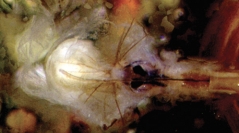

 Zoosystema
47 (22) - Pages 445-471
Zoosystema
47 (22) - Pages 445-471Copulatory damage during mating has been found in nine orders of Arthropoda, including beetles: in Carabidae Latreille, 1802, Meloidae Gyllenhaal, 1810, and two subfamilies of Chrysomelidae Latreille, 1802. Traumatic mating has been intensively studied in the genus Callosobruchus Pic, 1902 (Chrysomelidae, Bruchinae Latreille, 1802), in which males have sharp genital spines that damage the female bursa copulatrix. A single instance of traumatic mating has been demonstrated in the subfamily Galerucinae Latreille, 1802, in Monolepta elongata Jacoby, 1888, in which the male has long needle-like spines that penetrate the female bursa copulatrix. In this study I examined the endophalli of males, and the bursae of associated females, of 46 genera across all five subtribes of the tribe Galerucini Laboissiere, 1921. Of these 46 genera, 32 had sclerotized structures on the endophallus whereas in 14 genera the endophallus was a simple membranous sac. In males with modified endophalli, sharp spurs, cornuti, and elongate spiculae were most commonly encountered; some species also bore sclerotized bars that deployed upon everting the endophallus. Some species had sclerites bearing small knobs that suggested a stimulatory function in copulation. Species with spines that could potentially damage the females were encountered across the largest subtribes, as were females showing puncture scars on their bursae. However, individual cases were encountered in which males had dangerous-appearing endophalli, but females had no corresponding damage. Development of bursal sclerites in females was most evident in the Monoleptites Chapuis, 1875 (Luperina Wilcox, 1973), in which male endophallic spines were exceptionally numerous and elaborate. Pyrrhalta maculicollis (Motschulsky, 1853) is transferred to Xanthogaleruca Laboissière, 1934 under the name Xanthogaleruca maculicollis (Motschulsky, 1953) n. comb., and Metrioidea blakae (Wilcox, 1965) is transferred to Monolepta Chevrolat, 1837 under the name Monolepta blakae (Wilcox, 1965) n. comb. Some preliminary speculations are offered on how these structures might fit into current theories of copulatory behavior.